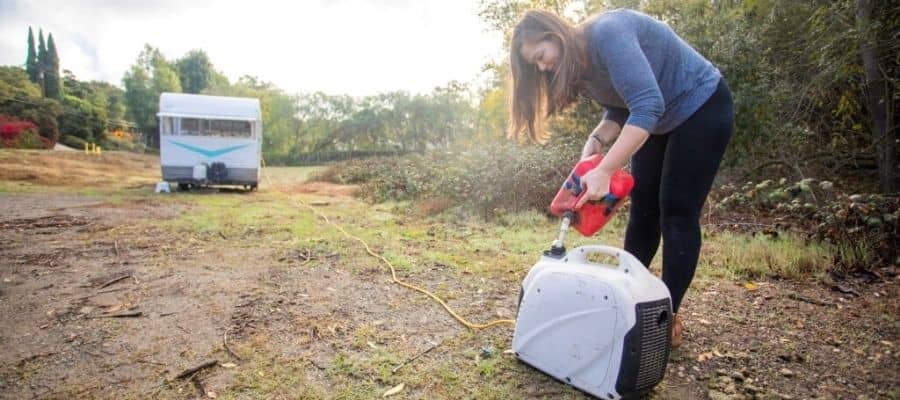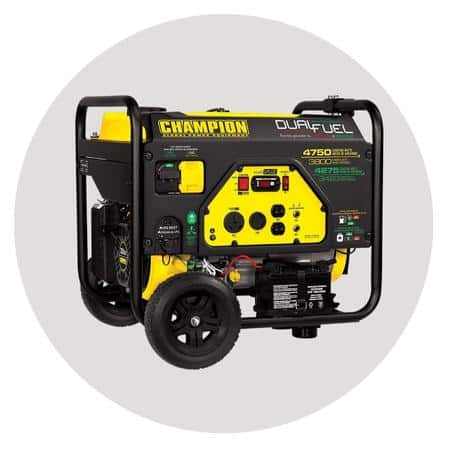
In the United States, RV camping is a popular hobby. You’ll have the opportunity to travel throughout the country and create unforgettable moments with your family. You don’t have to set up a tent, and you can relax in the comfort of your own home on wheels.
If you’re camping at an RV park, you can easily use a microwave and other appliances, but what if you’re out in the wilderness and don’t have access to a power outlet? It’ll suffice to use a portable generator.
When you’re not connected to shore power, you’ll need electricity, but how much will you require? What is the wattage required to run your air conditioner or appliances? When choosing the right size generator for your RV, there are a few things to keep in mind.
What Is an RV Generator?
Electricity may be generated in a variety of methods in most RVs. Onboard batteries are used to store energy, but they must be charged from outside sources. The alternator in the RV engine or the tow vehicle alternator provides some power to most RVs.
Many RVs feature solar panels to keep them charged. A generator, which operates on gas, diesel, or propane and creates 120-volt electricity, is another important power source found in many RVs.
Although a generator is rarely an RV’s only source of power, it does serve as a safety net in some situations. It’s what gives an RV its true self-contained status. When your batteries run out and you aren’t connected to shore power, you can use your generator.
As long as it has fuel, it will produce AC power instantly and reliably. It can also extend the life of the battery.
Some RVs feature built-in generators that power energy-intensive air conditioner systems. If you don’t already have one, a portable generator can be used as a backup power source. If necessary, you can run more than one in concurrently.
RV Generator Sizes
Let’s take a look at what’s available to assist you decide what size generator you need for your RV.
Generators are generally rated in terms of how many watts they produce. This is sometimes written as kilowatts. The majority of RV generators have a power range of 2,000 to 4,000 watts, or 2 to 4 kilowatts.
Portable RV Generator Sizes
Portable generators for RVs typically range from 2,000 to 5500 watts, although they may go up to 12,000 watts. In certain cases, bigger is better, but it also means it’s heavier, less fuel efficient, and louder. No one likes to add more weight to their RV unless it’s absolutely required.
Traditional generators are the most powerful and least expensive, but they’re noisy, inefficient, and prone to power spikes, so they shouldn’t be your first option for RV. Inverter generators are more efficient and quieter and manage voltage and current to protect sensitive electrical equipment such as computers and cell phones.
Built-In RV Generator Sizes
Many bigger RVs include built-in generators that are housed in a separate compartment. You may safely use them during transportation because they draw straight from the fuel tank or burn propane.
You may also configure them to turn on and off automatically or connect them into the electrical systems of your appliances. The power output varies, but it’s normally at least 4,000 watts and up to 10,000 watts.
Wattage Size
The size of the generator you’ll require is determined by the size of your RV. You won’t be using your RV generator to power all of your appliances and accessories at the same time, but you should be aware of how much power they consume.
Electric stoves and water heaters consume a significant amount of power, requiring roughly 2,000 watts apiece. A refrigerator, on the other hand, consumes 700 to 1000 watts.
You’ll need to know these figures in order to choose the right generator size for your RV lifestyle. If you have an RV most probably it will fall in a 30 Amp or 50-amp category. Some RVs have 30-amp service, while others have 50-amp service. The difference lies in the amount of power the RV can draw, which is determined by amperage and voltage.
Difference Between a 30 Amp and 50 Amp Service
The size and power capacity of RV connectors vary. Three prongs on a conventional 30-amp outlet are designed for RVs with fewer loads and lower power requirements. The four-prong 50-amp outlet is suitable for RVs with heavier loads.
Another significant distinction is the power capacity. A 30-amp service can deliver a maximum of 3,600 watts, but a 50-amp service can deliver up to 12,000 watts. The one you get will be determined by the make and model of your RV, and they are not usually interchangeable.
What Size Generator for a 30-Amp RV?
You’ll find a 120-volt, a neutral, and one ground wire in a typical RV. 30-amp generators have a lower amperage than 50-amp generators, making them more suited to RVs with lesser power demands.
The majority of conventional RVs in North America are 30-amp. You might wish to bring adapters if you have a bigger RV. If you utilize a 30-amp power supply in a 50-amp RV, however, you will have restricted power during your journey.
Multiply the number of volts (120) by the number of amps to get the maximum amount (30). Because the total is 3,600 watts, you can only utilize a 3,600-watt generator.
What Size Generator for a 50-Amp RV?
There are four wires in a 50 amp RV. There are 120V lines, a single ground wire, and one neutral wire in North American RVs. Other typical RVs, such as a 30-amp RV, have lesser amperage and a different plug configuration, yet their wires are identical to those of a 50-amp RV. The only difference is that one of the 120V wires is missing.
The magic number of maximum watts, according to the calculation, is 12,000. However, a generator far smaller than that can readily suffice. Even if you ran everything at the same time, it would be difficult to burn that much energy. 3,500 to 8,000 watts is a more reasonable range for a 50-amp RV.
Despite the fact that the RV can demand this much power, a 3500-watt generator may be utilized on a 50 amp RV; however, you must be aware that you will be power constrained. If the power output of the generator is exceeded, the generator will overload.
How Much Power Do You Need?
Many RVs in North American have 13,500 BTU air conditioners; thus 3500 watts should be plenty to keep your car running. With that in mind, 3500 watts is the very minimum you’ll require to operate your air conditioner and turn on a few lights.
If you want to utilize the majority of your appliances, you may require additional power. Here’s a brief rundown of how much electricity you’ll consume to run several basic RV items:
| Appliance | Average Load (Watts) | Amps |
| Air Conditioner (each) | 1700 | 14.1 |
| Refrigerator | 800 | 6.6 |
| Microwave Oven | 1250 | 10.4 |
| Electric Frying Pan/Wok | 1250 | 10.4 |
| Electric Stove Element | 675 | 5.6 |
| Electric Water Heater (6 gallon) | 1250 | 10.4 |
| Toaster | 1200 | 10 |
| Hand Vacuum | 240 | 2 |
| Crock Pot | 230 | 1.9 |
| Satellite Dish and Receiver | 200 | 1.7 |
With this in mind, a 3,000-watt generator should be plenty to power your RV. Any generator with higher power will be more difficult to travel with and move. If you’re still worried about running out of power, try turning on one device at a time to see how far your power supply can go.
Remember that the statistics above are estimations, and various brands will require varying amounts of power. Make a note of all your appliances and their overall wattage to figure out how much power you’ll require. That way, you’ll be able to get an inverter generator with the right quantity of power.
Can I Connect 50 amp RV Into a 30 amp?
Yes, to put it bluntly. If you have the correct adaptor, you can plug a 50-amp RV into a 30-amp power supply. With that in mind, using a 30-amp power supply won’t provide you the full power for a 50-amp RV.
A 30-amp service does have a working wattage of 3,600 watts, whereas a 50-amp RV has a total wattage of 12,000 watts. So, 3,600 watts isn’t nearly enough to meet the demands of a 12,000-watt automobile.
With an adaptor, you can connect your 50-amp RV to a 30-amp service, but you’ll get less power. That means you won’t be able to operate all of your appliances at the same time, and you won’t be able to have too many lights on.
Fuel Type
When purchasing a generator for your RV, you must be aware of the many fuel sources available. Diesel is used to power traditional generators. Other types that use gasoline or propane, depends on where you wish to go camping, are available.
To optimize your possibilities when you move to different sites throughout your camping vacation, look for models that handle two or more fuel types. You may use a dual fuel generator to take advantage of different fuel supply in different areas.
Conventional vs. Inverter
An alternator is used in a traditional generator to obtain electrical power. A fossil fuel, such as diesel, or LPG, is the most frequent fuel source for a traditional generator.
Traditional generators create 120 volts and 60 Hz power at 3600 RPM. These generators, on the other power, frequently struggle to sustain 3600 RPM and are prone to power spikes (also known as “not pure sine wave”).
Inverters provide clean energy, which is a dependable source of power. An inverter is a significantly better solution since modern electrical equipment require clean power to operate.
Our Recommendation: Champion 3800-Watt Dual Fuel RV Ready Portable Generator

The Champion 3800 is a powerful RV generator that can run on both gasoline and propane. It has a 223CC engine that produces 3800 watts. At half load, this generator will run for up to 9 hours while generating only 68dBA of noise.
It also features a normal 30 amp RV outlet, allowing you to power most equipment in your RV, including a 15,000 BTU RV air conditioner.
It’s also quite simple to start the Champion 3800—all you have to do is press a button. Thanks to a battery that charges while the generator operates, your generator will be ready to go at any time. For those chilly camping seasons, it also has cold-start technology.
The Champion 3800 has a portable design with durable, folding handlebars and a never-flat tire, making it easy to transport. Your appliances are additionally protected from power spikes thanks to the built-in volt guard. As a drawback, you simply have to deal with a little noise.
Read Next:
- Duromax XP12000 EH Review – Is It Worth It This Year?
- Battery Powered Generator for Refrigerator -Review
